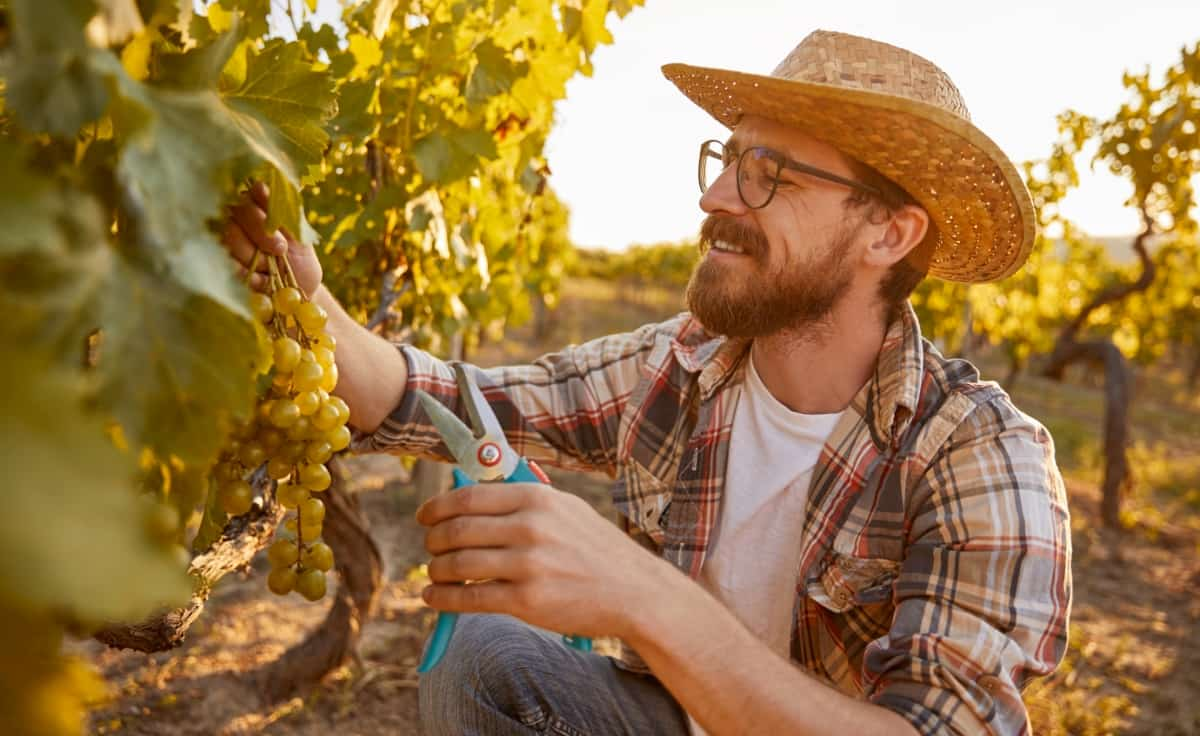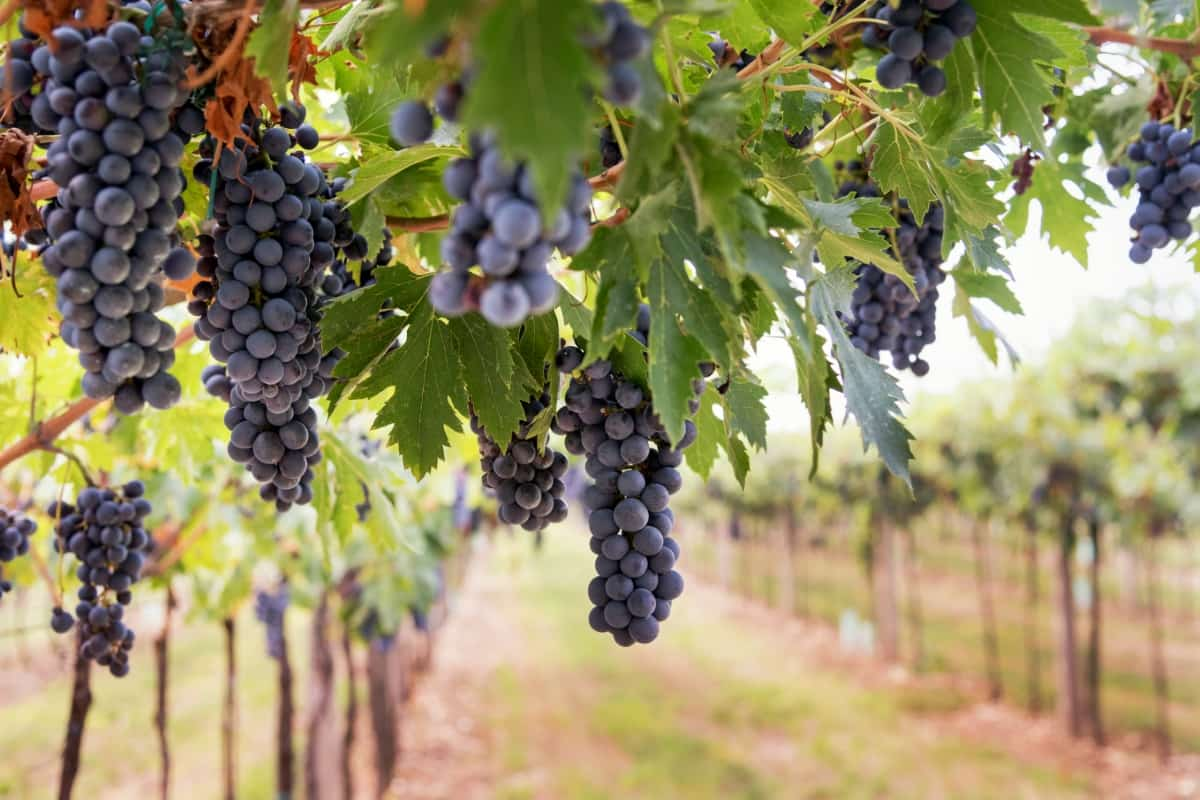Seedless grapes are a popular fruit crop renowned for their sweet and juicy berries. These grapes belong to the Vitis vinifera species and are prized for their convenience and excellent flavor. They are typically grown in temperate regions with well-drained soil and plenty of sunlight. Seedless grapes are a versatile fruit enjoyed fresh, as raisins, or transformed into various grape products like wine or grape juice. Their popularity in the global fruit market continues to grow due to their delectable taste and easy consumption.

Seedless Grapes Cultivation
History
The history of seedless grapes traces back to Ancient Rome, where early horticulturists sought to develop this prized trait. However, it was in the mid-1870s that a breakthrough occurred in the U.S. A Scottish immigrant bearing the name Thompson introduced a particular seedless variety, primarily for raisin production. This variety, aptly named Thompson Seedless, became a cornerstone of the seedless grape industry. Many of the seedless grapes cultivated today owe their existence, at least in part, to the genetic lineage of the Thompson variety.
Botanical Classification
Seedless grapes belong to the plant genus Vitis, which encompasses various grape species. Specifically classified as Vitis vinifera, they are part of the larger Vitaceae family, commonly known as the grape family. Seedless grapes within the Vitis vinifera species are further categorized into various cultivars or varieties, each with distinct characteristics. These cultivars have been selectively bred over centuries for desirable traits like sweetness, color, and size. Examples include the well-known Thompson Seedless and Flame Seedless varieties.
Varieties
- Thompson Seedless: Known for its golden-green berries, often used for raisins and fresh consumption.
- Flame Seedless: Crimson-red grapes with a sweet and slightly tart taste, ideal for snacking.
- Red Globe: Large, round, red grapes, prized for their size and crisp texture.
- Crimson Seedless: Small to medium-sized red grapes with a sweet and tangy flavor.
- Autumn Royal: Dark purple grapes with a rich, sweet taste, often enjoyed fresh.
- Sugraone: Green grapes, appreciated for their juiciness and sweet flavor.
Growing Conditions
They should be planted in a sunny spot with well-drained soil, preferably loamy or sandy. Adequate spacing between vines is essential for air circulation. Pruning and trellising support vine health and grape quality. These vines are typically grown in regions with a temperate climate, as they need a chilling period during the winter. Regular irrigation, especially during the growing season, is crucial, and proper fertilization should provide nutrients.
Soil Requirements
Well-drained soil is essential to prevent waterlogging, as excess moisture can damage the roots. A loamy or sandy soil texture is preferred because it offers good drainage and aeration, reducing the risk of root diseases. The soil should be a bit acidic to a neutral pH level, typically between 6.5 and 8.0. This pH range ensures nutrient availability to the vines. Also, the soil should be rich in organic matter, as it aids moisture retention and provides essential nutrients.
In case you missed it: How to Grow and Care for Bonsai Grapes: Planting Instructions

Propagation
- Cuttings: This is the most common method. Cuttings from healthy, mature vines are planted in soil or a growth medium, where they develop roots and grow into new plants.
- Grafting: A seedless grape variety is grafted onto a rootstock chosen for its disease resistance and vigor. This method allows for precise control of the grapevine’s characteristics.
- Layering: A low-growing vine branch is bent to the ground, buried, and encouraged to develop roots before being separated from the parent plant.
- Tissue Culture: A more advanced technique involving plant tissue manipulation in a laboratory to produce disease-free grapevines.
Planting Techniques and Timing
Planting seedless grapes is best done in early spring when the soil is workable but not waterlogged. Begin by digging a hole large enough to accommodate the grapevine’s root system, typically around 2-3 feet deep and wide. Place the vine in the hole, ensuring it’s at the same depth as in the nursery. Backfill with soil, tamp it down gently, and water thoroughly. Proper spacing between vines, usually 6-10 feet apart in rows, is essential. Additionally, using trellises or support systems helps with training and vine management as the grapes grow.
Irrigation and Water Management
Grapes require consistent soil moisture, especially during the growing season, to support vine health and fruit development. Drip irrigation or soaker hoses are often employed to provide controlled and efficient water delivery, minimizing leaf wetness to reduce disease risk. It’s important to avoid overwatering, which can lead to root problems, and underwatering, which can stress the vines and reduce yield.
Nutrient Management
Soil testing helps determine nutrient deficiencies, allowing growers to apply the right fertilizers. Typically, grapes require nitrogen, phosphorus, and potassium, but other nutrients like magnesium and calcium are also important. Organic matter improves soil fertility and nutrient retention. Balanced nutrition supports healthy vine growth, fruit development, and disease resistance. Regular monitoring and foliar analysis ensure the grapevines receive the necessary nutrients, promoting vigorous growth and high-quality fruit production while minimizing nutrient-related issues.
Pest and Disease Control
Integrated pest management (IPM) strategies include monitoring for pests like aphids, grapevine moths, and spider mites and early intervention through biological controls or minimal pesticide use. Fungal diseases like powdery and downy mildew are managed with fungicides and regular vine canopy management to improve air circulation. Pruning practices, weed control, and disease-resistant grape varieties reduce pests and disease risk, ensuring a healthy and productive seedless grape crop.
In case you missed it: 9 Causes of Dying Grape Vines and How to Fix Them

Harvesting and Post-Harvest Handling
Harvesting seedless grapes occurs typically in late summer to early autumn when they reach their desired sweetness and color. Grapes are handpicked to prevent damage to the delicate berries. Careful handling is essential to avoid bruising or splitting. After harvest, grapes are sorted, removing damaged or unripe clusters.
They are then cooled and packed in perforated containers to maintain freshness. Proper storage at cool temperatures, usually around 0°C, and controlled humidity extends their shelf life. Seedless grapes are sensitive to moisture, so post-harvest handling focuses on preserving their quality, taste, and appearance.
Buying Seedless Grape Seeds
If you want to grow seedless grapes, you can buy grapevine cuttings or plants from nurseries, garden centers, or online gardening suppliers. Look for grape varieties labeled as “seedless” or “table grapes.” You won’t find seedless grape seeds for sale because they don’t exist due to the nature of seedless grapes.
In case you missed it: How to Increase Female Flowers in Grapes: Explained in 10 Simple Steps for High Yields and Profit

Conclusion
Proper care, including pruning, pest control, and irrigation, is essential for achieving optimal yields. Regular monitoring and adjustments to cultivation practices can also help maximize grape production. Remember to consult with local agricultural extension services or grape-growing experts for region-specific recommendations and best practices.
- Feed Your Flock for Less: Top 10 Tips to Save on Chicken Feed
- Ultimate Guide to Ossabaw Island Hog: Breeding, Raising, Diet, and Care
- Hatching Answers: The Top 10 Reasons Your Chickens Aren’t Laying Eggs
- Eggs and Economics: Breaking Down the Cost of Raising Backyard Chickens
- Defend Your Greens: Proven Methods to Keep Iguanas Out of Your Garden
- Ultimate Guide to Cinnamon Queen Chicken: A Comprehensive Guide for Beginners
- Ultimate Guide to California Tan Chicken: Breeding, Raising, Diet, Egg-Production and Care
- Ultimate Guide to Marsh Daisy Chicken: Breeding, Raising, Diet, and Care
- 10 Types of Chicken Farming Businesses You Can Start for Profits